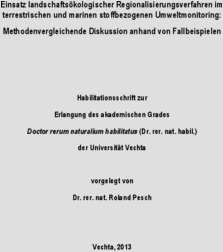| dc.contributor.author | Pesch, Roland | |
| dc.date.accessioned | 2016-08-17T15:22:51Z | |
| dc.date.available | 2016-08-17T15:22:51Z | |
| dc.date.issued | 2016-08-17 | |
| dc.identifier.uri | http://hdl.handle.net/11858/00-1735-0000-002B-96A3-3 | |
| dc.description.abstract | Die quantitative Landschaftsökologie beschäftigt sich mit der räumlichen Abgrenzung von Landschaftsstrukturen auf unterschiedlichen räumlichen Skalen sowie mit den dort beobachtbaren Wechselwirkungen zwischen der belebten und unbelebten Umwelt. Obwohl die Landschaftsökologie in ihrem Ursprung eine terrestrisch orientierte Fachdisziplin ist, sollten deren Methoden auch auf den aquatischen Bereich übertragbar sein, denn auch hier existieren in Abhängigkeit der topografischen, hydrografischen und sedimentologischen Voraussetzungen in sich homogene Lebensraumstrukturen, die man als Landschaften auffassen kann. Ein sich entwickelnder Bedarf an geeigneten planerischen Methoden und Konzepten im marinen Umweltmonitoring ergibt sich aus aktuellem Anlass: Am 17. Juni 2008 wurde die Meeresstrategie-Rahmenrichtlinie (MSRL) durch Beschluss des Europäischen Parlaments und des Rates in der Europäischen Union eingeführt. Die MSRL zielt auf eine umweltgerechte Bewirtschaftung der Meere ab und strebt die Erlangung eines Guten Umweltzustands in den europäischen Meeren bis 2020 an. Mit der Richtlinie erhöhen sich die Anforderungen an die Planung und Überwachung des Zustands der marinen Gewässer in Europa. Neben einer Anfangsbewertung der Meeresgebiete der Mitgliedsstaaten sowie der darauf aufbauenden Festlegung des Guten Umweltzustands anhand abiotischer und biotischer Merkmale und von Umweltzielen sollen auch Maßnahmen zur Erreichung dieser Ziele umgesetzt werden. Der Erfolg dieser Maßnahmen soll durch eine Überwachung des Zustands der Meeresgebiete begleitet werden. Entsprechende Monitoring-Programme sollen eine laufende Bewertung des Umweltzustands anhand chemisch-physikalischer und biologischer Merkmale zulassen. Im Hinblick auf die Planung landschaftsökologisch repräsentativer, auf die Optimierung von Suffizienz- und Effizienzkriterien ausgerichteter Umweltmessnetze in der deutschen Nordsee widmet sich vorliegende Habilitationsschrift der Überprüfung der Übertragbarkeit zweier Methoden der quantitativen Landschaftsökologie in den marinen Raum am Beispiel der deutschen Nordsee. Neben der datenbasierten Ableitung landschaftsökologischer Raumgliederungen für den erweiterten Bereich der deutschen Nordsee mittels statistischer Methoden steht dabei die für die Erfassung des Landschaftshaushalts landschaftsökologisch repräsentative Planung stoffbezogener Umweltmessnetze im Mittelpunkt. | |
| dc.description.abstract | Quantitative landscape ecology is concerned with the regional classification of landscape structures on various spatial scales, including the here observed interactions between the biological and abiotic environment. Despite the fact that landscape ecology has originally been a terrestrial research field, its methods should be applicable to the aquatic environment. Depending on the prevailing topographical, hydrographical, and sedimentological conditions, homogeneous benthic habitat structures, which we may be referred to as landscapes, do exist here as well. A developing demand for adequate planning methods and concepts in the field of marine environmental monitoring ensues in the light of current events. On July 17, 2008 the Marine Strategy Framework Directive (MSFD) was introduced by a resolution of the European Parliament and the Council of the European Union. The MSFD is targeted on an environmentally sound management of European oceans and aims at achieving a Good Environmental Status (GES) for European marine waters by the year 2020. The directive increases marine planning requirements with respect to monitoring the condition of marine waters in Europe. Apart from an initial assessment of the marine areas of the member states and the ensuing determination of the GES with regard to biotic and abiotic characteristics, as well as the definition of environmental objectives, adequate measures to reach these goals shall also be implemented. The success of these measures is to be accompanied by monitoring activities with regard to the chemical, physical and biological parameters of the marine environment. The question of where to monitor is decided for and discussed within the German Marine Monitoring Programme of the federation and the federal states. Taking the extended area of the German North Sea as an example, the habilitation thesis here submitted focuses on verifying the transferability of two application areas of terrestrial quantitative landscape ecology to the marine environment in order to assist the planning of monitoring networks in Germany’s marine waters. Next to the data-based derivation of landscape ecoregionalizations by means of statistical methods, another focus is set on the landscape-ecologically representative planning of substance based environmental monitoring networks. | |
| dc.format.extent | 203 S. | |
| dc.language.iso | ger | |
| dc.subject.ddc | 551 | |
| dc.subject.gok | QD 000 | |
| dc.title | Einsatz landschaftsökologischer Regionalisierungsverfahren im terrestrischen und marinen stoffbezogenen Umweltmonitoring: Methodenvergleichende Diskussion anhand von Fallbeispielen | |
| dc.type | monograph | |
| dc.subject.gokverbal | Physische Geographie / Landschaftsökologie | |
| dc.identifier.doi | 10.23689/fidgeo-2003 | |
| dc.type.version | draft | |
| dc.subject.free | Marine Landschaftsökologie | |
| dc.subject.free | Biotopkartierung | |
| dc.subject.free | Ökogliederung | |
| dc.subject.free | Multivariate Statistik | |
| dc.subject.free | Geostatistik | |
| dc.subject.free | Quantitative Landschaftsökologie | |
| dc.description.type | thesis | |


